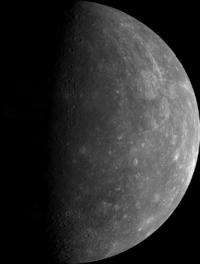MESSENGER's X-ray spectrometer reveals chemical diversity on Mercury's surface

(Phys.org)—New data from the X-Ray Spectrometer (XRS) on the MESSENGER spacecraft—one of two instruments designed to measure the abundances of many key elements on Mercury—show variations in the composition of surface material on Mercury that point to changes over time in the characteristics of volcanic eruptions on the solar system's innermost planet.
In results to be published in the Journal of Geophysical Research, scientists report that Mercury's volcanic smooth plains units differ in composition from older surrounding terrains. The older terrain has higher ratios of magnesium to silicon, sulfur to silicon, and calcium to silicon, but lower ratios of aluminum to silicon, suggesting that the smooth plains material erupted from a magma source that was chemically different from the source of the material in the older regions, explains Shoshana Weider of the Carnegie Institution of Washington, the lead author on the paper.
"The new findings further illuminate the geological history of the planet," she says. "We now know that these areas are compositionally distinct, indicating that different parts of Mercury's mantle melted at different times and temperatures, and through volcanic activity created the materials in the different terrains."
Weider and her co-authors also report that Mercury's surface is dominated by minerals high in magnesium and enriched in sulfur.
"None of the other terrestrial planets have such high levels of sulfur. We are seeing about ten times the amount of sulfur than on Earth and Mars," Weider says. "In terms of magnesium, we do have some materials on Earth that are high in magnesium. They tend to be ancient volcanic rocks that formed from very hot lavas. So this composition on Mercury tells us that eruptions of high-temperature lavas might have formed these high-magnesium materials."
These findings stem from the team's analysis of 205 X-ray measurements of Mercury's surface, focusing on the large expanse of smooth volcanic plains at high northern latitudes and surrounding areas that are higher in crater density and therefore older than the northern plains. Weider says the measurements support what other MESSENGER scientists have observed from the mission's images. "Now we can correlate their findings with our data, providing increased confidence in what we are discovering about the planet," she says.
MESSENGER has been orbiting Mercury since March 2011, and has been revealing new information about the surface chemistry and geological history of the innermost planet in the solar system. The XRS measures elemental abundances on the surface of Mercury by detecting fluorescent X-ray emissions induced on the planet's surface by the incident solar X-ray flux. The instrument began orbital observations on March 23, 2011, and has observed X-ray fluorescence from the surface of the planet whenever a sunlit portion of Mercury has been within the XRS field of view.
"The X-ray spectrometer focuses on the estimation of elemental abundances on Mercury; i.e., the amount of magnesium, aluminum, sulfur, calcium, and iron in surface material," Weider says. "From there we can start to work out what kinds of minerals are present, then the types of rocks that were formed, and then we can start to unravel the geological history."
Journal information: Journal of Geophysical Research
Provided by NASA




















